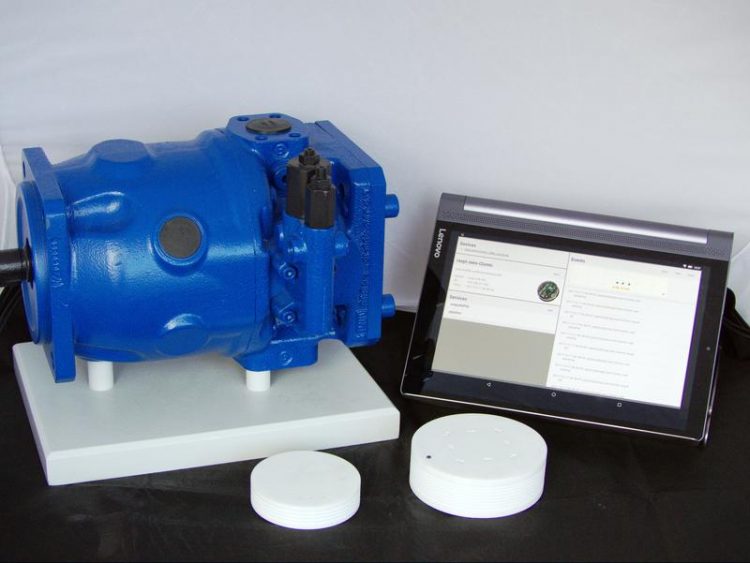Hannover Messe 2018: Cognitive system for predictive acoustic maintenance

Predictive Maintenance at Hannover Messe: configured wireless sensor nodes (in the foreground) send status messages of the axial piston pump (left) to a tablet. Picture © Fraunhofer IDMT
Axial piston pumps convert mechanical into hydraulic energy. On construction or agricultural machinery, they help to lift heavy loads or are part of industrial conveyor technology.
“So far, these systems have not had permanently installed acoustic condition monitoring”, reports Danilo Hollosi, Head of “Acoustic Event Recognition” of the Oldenburg Project Group for Hearing, Speech and Audio Technology at the Fraunhofer Institute for Digital Media Technology IDMT. “Cognitive systems can be very powerful in this regard. We have illustrated this with our new demonstrator.”
Recognize early when it is no longer running smoothly
Together with partners, the scientists have mounted on axial piston pumps batteryoperated sensors that are able to record the noise of the pump via the air, to process it, to compare it with reference audio data and to send the information wirelessly to a digital evaluation unit.
Not only can conclusions about possible undesirable developments be identified at an early stage; statements about the nature of the problems can also be made – for example, if there are problems concerning bearing clearance or hydraulics. This provides the opportunity to intervene before major damage to powertrains or hydraulics occurs.
Use of machine learning methods
“We have trained the cognitive system with machine learning based on previously acquired pump audio signals”, Hollosi says. A central infrastructure for data processing is not necessary. This saves costs: while servers can consume amounts in the five-digit range, the price per sensor remains in the double-digits. Another advantage: signal processing on site will require less data for training. “Customers benefit from a datasecure technology platform that is suitable for a wide variety of audio scenarios andthat can be easily retrofitted and scaled to any size.
The networking of sensors via the Internet for remote maintenance is also possible”, Hollosi adds, summarizing the advantages. In this process, the Fraunhofer IDMT incorporates the expertise of its project group Hearing, Speech and Audio Technology in Oldenburg. “Our colleagues are experts in technologically recreating the capabilities of the human ear. They teach the systems to adhere to given parameters when evaluating audio data, to take into account environmental noise patterns and to exclude out background noise”, says Hollosi.
Ready for the market: Technology Readiness Level 8
The technology is funded by the BMBF (German Federal Ministry of Education and Research) in the ACME 4.0 project. In the meantime, the partners have reached the 3rd project year and Technology Readiness Level 8. “Our prototype works,” says Hollosi. In 2018, it will be field-tested. At the same time, the scientists are working with Infineon on predictive maintenance for chip production. The demonstrator will be shown by the Fraunhofer IDMT at the Hanover Trade Fair: A loudspeaker will play the operating noise of the axial piston pump. Wireless sensor nodes can be configured via a tablet. The feedback on the detected acoustic event is then displayed on the tablet.
Media Contact
All latest news from the category: Trade Fair News
Newest articles

High-energy-density aqueous battery based on halogen multi-electron transfer
Traditional non-aqueous lithium-ion batteries have a high energy density, but their safety is compromised due to the flammable organic electrolytes they utilize. Aqueous batteries use water as the solvent for…

First-ever combined heart pump and pig kidney transplant
…gives new hope to patient with terminal illness. Surgeons at NYU Langone Health performed the first-ever combined mechanical heart pump and gene-edited pig kidney transplant surgery in a 54-year-old woman…

Biophysics: Testing how well biomarkers work
LMU researchers have developed a method to determine how reliably target proteins can be labeled using super-resolution fluorescence microscopy. Modern microscopy techniques make it possible to examine the inner workings…





















